 W
WA forest product is any material derived from forestry for direct consumption or commercial use, such as lumber, paper, or forage for livestock. Wood, by far the dominant product of forests, is used for many purposes, such as wood fuel or the finished structural materials used for the construction of buildings, or as a raw material, in the form of wood pulp, that is used in the production of paper. All other non-wood products derived from forest resources, comprising a broad variety of other forest products, are collectively described as non-timber forest products (NTFP). Non-timber forest products are viewed to have fewer negative effects on forest ecosystem when providing income sources for local community.
 W
WIn agriculture, gardening, and landscaping, barkdust is a form of mulch produced out of chipped or shredded tree bark. Coarser forms of barkdust may be known as bark nuggets. Trees typically used in the production of barkdust include the Douglas fir and the Western hemlock.
 W
WBioenergy Europe is a European trade association open to national biomass associations and bioenergy companies active in Europe. It was founded in 1990 under the leadership of French senator Michel Souplet with the aim to promote energy generation from biomass - in all its forms: biopower, bioheat or biofuels for transport. Bioenergy Europe is the umbrella organisation of the European Pellet Council (EPC), and the International Biomass Torrefaction Council (IBTC).
 W
WA butter stamp, is a device for stamping a design onto a block of warm butter. They were sometimes commercial but usually purely decorative and applied in homes. The stamps are typically made of wood, and feature simple designs, of cows, flowers or geometric designs and, if commercial, the name of the retailer. Often they form part of a box-like mould for forming the whole block. Other designs achieved the same effect by carving the design at the bottom of a butter mould. Part of the intent for commercial moulds and stamps was to demonstrate consistency in the quantity of butter sold. Both moulds and stamps are now normally inexpensive antiques.
 W
WClapboard, also called bevel siding, lap siding, and weatherboard, with regional variation in the definition of these terms, is wooden siding of a building in the form of horizontal boards, often overlapping.
 W
WA cooper is a person trained to make wooden casks, barrels, vats, buckets, tubs, troughs and other similar containers from timber staves that were usually heated or steamed to make them pliable.
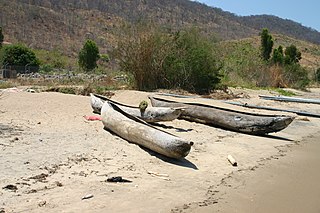 W
WA dugout canoe or simply dugout is a boat made from a hollowed tree. Other names for this type of boat are logboat and monoxylon. Monoxylon (μονόξυλον) is Greek -- mono- (single) + ξύλον xylon (tree) -- and is mostly used in classic Greek texts. In German, they are called Einbaum. Some, but not all, pirogues are also constructed in this manner.
 W
WEma are small wooden plaques, common to Japan, in which Shinto and Buddhist worshippers write prayers or wishes. The ema are left hanging up at the shrine, where the kami are believed to receive them. Typically 15 cm wide and 9 cm high, they often carry images or are shaped like animals, or symbols from the zodiac, Shinto, or the particular shrine or temple. In ancient times people would donate horses to the shrines for good favor; over time this was transferred to a wooden plaque with a picture of a horse, and later still to the various wooden plaques sold today for the same purpose. Once inscribed with a wish, Ema are hung at the shrine until they are ritually burned at special events, symbolic of the liberation of the wish from the writer.
 W
WA lath or slat is a thin, narrow strip of straight-grained wood used under roof shingles or tiles, on lath and plaster walls and ceilings to hold plaster, and in lattice and trellis work.
 W
WLiquid smoke is a water-soluble yellow to red liquid used for flavoring. It is used as a substitute for cooking with wood smoke while retaining a similar flavor. It can be used to flavor any meat or vegetable. It is generally made by condensing the smoke from wood, but can contain any number of food additives.
 W
WLumber, also known as timber, is a type of wood that has been processed into beams and planks, a stage in the process of wood production. Lumber is mainly used for structural purposes but has many other uses as well.
 W
WThe mast of a sailing vessel is a tall spar, or arrangement of spars, erected more or less vertically on the centre-line of a ship or boat. Its purposes include carrying sails, spars, and derricks, and giving necessary height to a navigation light, look-out position, signal yard, control position, radio aerial or signal lamp. Large ships have several masts, with the size and configuration depending on the style of ship. Nearly all sailing masts are guyed.
 W
WMatchboard by definition is "a board with a groove cut along one edge and a tongue along the other so as to fit snugly with the edges of similarly cut boards."
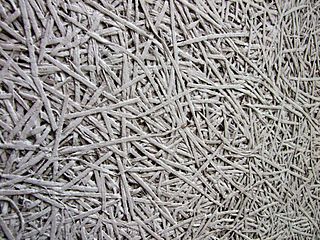 W
WMineral bonded wood wool boards are building boards made of wood wool fibres, water and the binding agents cement, caustic magnesia and gypsum. Mineral bound wood wool boards are used in a wide range of applications, e.g., thermal insulation, acoustic insulation, indoor decoration, etc.
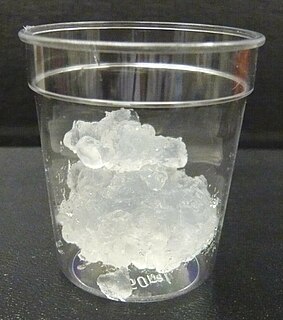 W
WNanocellulose is a term referring to nano-structured cellulose. This may be either cellulose nanocrystal, cellulose nanofibers (CNF) also called nanofibrillated cellulose (NFC), or bacterial nanocellulose, which refers to nano-structured cellulose produced by bacteria.
 W
WPine tar is a sticky material produced by the high temperature carbonization of pine wood in anoxic conditions. The wood is rapidly decomposed by applying heat and pressure in a closed container; the primary resulting products are charcoal and pine tar.
 W
WThe pith helmet, also known as the safari helmet, sun helmet, topee, sola topee or topi, is a lightweight cloth-covered helmet made of sholapith. The pith helmet is an adaptation of the native salakot headgear of the Philippines.
 W
WPulp is a lignocellulosic fibrous material prepared by chemically or mechanically separating cellulose fibers from wood, fiber crops, waste paper, or rags. Mixed with water and other chemical or plant-based additives, pulp is the major raw material used in papermaking and the industrial production of other paper products.
 W
WA railroad tie, crosstie, railway tie or railway sleeper is a rectangular support for the rails in railroad tracks. Generally laid perpendicular to the rails, ties transfer loads to the track ballast and subgrade, hold the rails upright and keep them spaced to the correct gauge.
 W
WReclaimed lumber is processed wood retrieved from its original application for purposes of subsequent use. Most reclaimed lumber comes from timbers and decking rescued from old barns, factories and warehouses, although some companies use wood from less traditional structures such as boxcars, coal mines and wine barrels. Reclaimed or antique lumber is used primarily for decoration and home building, for example for siding, architectural details, cabinetry, furniture and flooring.
 W
WSawdust is a by-product or waste product of woodworking operations such as sawing, milling, planing, and routing. It is composed of small chippings of wood. These operations can be performed by woodworking machinery, portable power tools or by use of hand tools. Wood dust is also the byproduct of certain animals, birds and insects which live in wood, such as the woodpecker and carpenter ant. In some manufacturing industries it can be a significant fire hazard and source of occupational dust exposure.
 W
WThe scutum was a type of shield used among Italic peoples in antiquity, and then by the army of ancient Rome starting about the fourth century BC. The Romans adopted it when they switched from the military formation of the hoplite phalanx of the Greeks to the formation with maniples. In the former, the soldiers carried a round shield, which the Romans called a clipeus. In the latter, they used the scutum, which was a larger shield. Originally it was an oblong and convex shield. By the first century BC it had developed into the rectangular, semi-cylindrical shield that is popularly associated with the scutum in modern times. This was not the only shield the Romans used; Roman shields were of varying types depending on the role of the soldier who carried it. Oval, circular and rectangular shields were used throughout Roman history.
 W
WShiplap is a type of wooden board used commonly as exterior siding in the construction of residences, barns, sheds, and outbuildings.
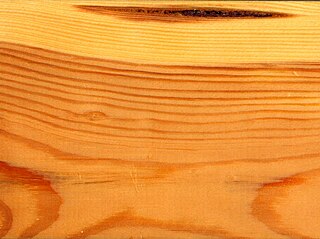 W
WSoftwood is wood from gymnosperm trees such as conifers, as well as Amborella. The term is opposed to hardwood, which is the wood from angiosperm trees.
 W
WA Swedish torch is a source of heat and light from a vertically set tree trunk, incised and burning in the middle. It became known in Europe during the 1600s and is now used by forest workers, and for leisure activities. Due to its flat surface and good embers, it can also be used for cooking. Compared to a campfire, it is more compact, and therefore several small heat sources can be distributed over an area.
 W
WTannins are a class of astringent, polyphenolic biomolecules that bind to and precipitate proteins and various other organic compounds including amino acids and alkaloids.
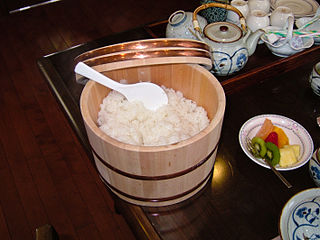 W
WA tub is an open-top circular or oblong container. In earlier times they were made from wooden staves held together with iron hoops and were made by coopers. Modern tubs used in industry might be made from concrete, metal or plastic.
 W
WWood is a porous and fibrous structural tissue found in the stems and roots of trees and other woody plants. It is an organic material – a natural composite of cellulose fibers that are strong in tension and embedded in a matrix of lignin that resists compression. Wood is sometimes defined as only the secondary xylem in the stems of trees, or it is defined more broadly to include the same type of tissue elsewhere such as in the roots of trees or shrubs. In a living tree it performs a support function, enabling woody plants to grow large or to stand up by themselves. It also conveys water and nutrients between the leaves, other growing tissues, and the roots. Wood may also refer to other plant materials with comparable properties, and to material engineered from wood, or wood chips or fiber.
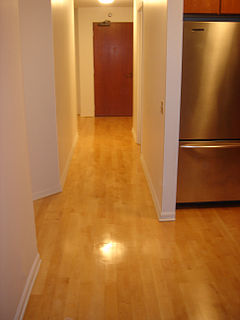 W
WWood flooring is any product manufactured from timber that is designed for use as flooring, either structural or aesthetic. Wood is a common choice as a flooring material and can come in various styles, colors, cuts, and species. Bamboo flooring is often considered a form of wood flooring, although it is made from a grass (bamboo) rather than a timber.
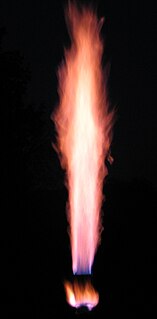 W
WWood gas is a syngas fuel which can be used as a fuel for furnaces, stoves and vehicles in place of gasoline, diesel or other fuels. During the production process biomass or other carbon-containing materials are gasified within the oxygen-limited environment of a wood gas generator to produce hydrogen and carbon monoxide. These gases can then be burnt as a fuel within an oxygen rich environment to produce carbon dioxide, water and heat. In some gasifiers this process is preceded by pyrolysis, where the biomass or coal is first converted to char, releasing methane and tar rich in polycyclic aromatic hydrocarbons.
 W
WIn woodworking, veneer refers to thin slices of wood and sometimes bark, usually thinner than 3 mm, that typically are glued onto core panels to produce flat panels such as doors, tops and panels for cabinets, parquet floors and parts of furniture. They are also used in marquetry. Plywood consists of three or more layers of veneer. Normally, each is glued with its grain at right angles to adjacent layers for strength. Veneer beading is a thin layer of decorative edging placed around objects, such as jewelry boxes. Veneer is also used to replace decorative papers in Wood Veneer HPL. Veneer is also a type of manufactured board.
 W
WWood wool, known primarily as excelsior in North America, is a product made of wood slivers cut from logs. It is mainly used in packaging, for cooling pads in home evaporative cooling systems known as swamp coolers, for erosion control mats, and as a raw material for the production of other products such as bonded wood wool boards. In the past it was used to fill stuffed toys. It is also sometimes used by taxidermists to construct the armatures of taxidermy mounts.
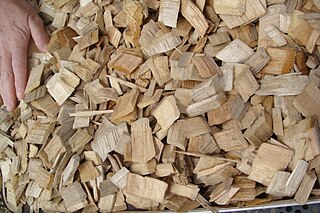 W
WWoodchips are small- to medium-sized pieces of wood formed by cutting or chipping larger pieces of wood such as trees, branches, logging residues, stumps, roots, and wood waste.
 W
WA woodie is a type of station wagon where the rear car bodywork is constructed of wood or is styled to resemble wood elements.